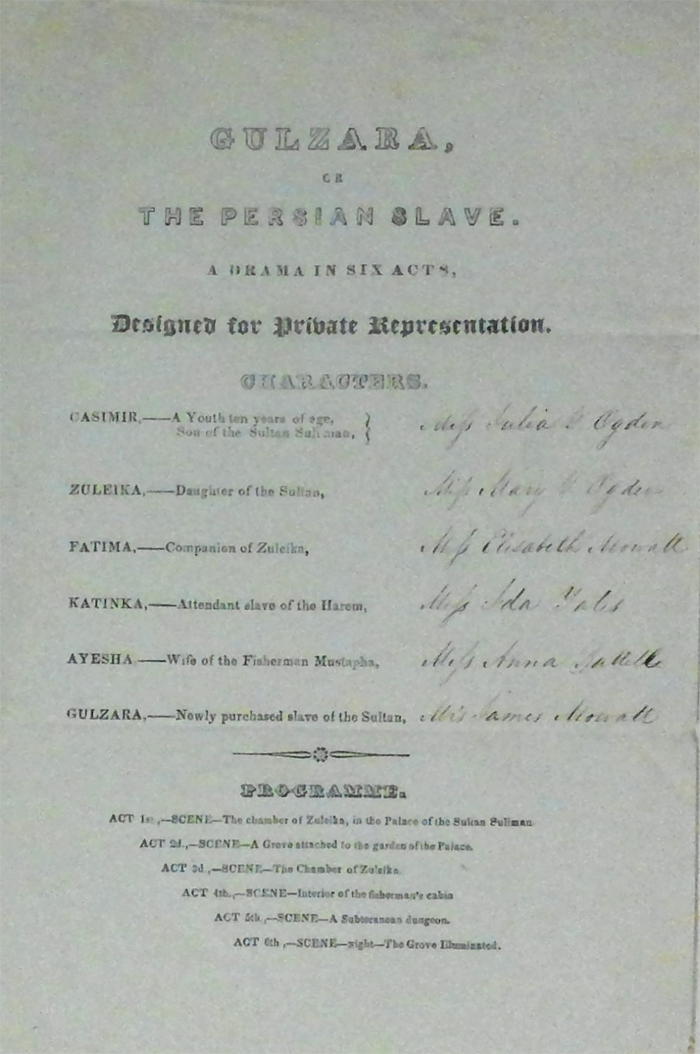

| |
Gulzara; or the Persian Slave A Drama in Five Acts
“Gulzara, The Persian Slave” is a rare example of a script
for a Victorian melodrama that was intended as a private theatrical – to be
performed by a limited cast of Characters
 In
her autobiography, Mowatt states that she played Gulzara. Her
youngest sister, Julia played the Sultan's son, and her sister
May took the role of Princess Zulieka. Biographer Eric Woollencott
Barnes informs us that Elizabeth Mowatt (James' younger sister,) Ida
Yates (an Ogden niece,) and an old school friend, Anna Battelle filled out the rest of the cast. In
her autobiography, Mowatt states that she played Gulzara. Her
youngest sister, Julia played the Sultan's son, and her sister
May took the role of Princess Zulieka. Biographer Eric Woollencott
Barnes informs us that Elizabeth Mowatt (James' younger sister,) Ida
Yates (an Ogden niece,) and an old school friend, Anna Battelle filled out the rest of the cast.
Production History Anna Cora Mowatt wrote
"Gulzara" to be performed at at a party at her residence, Melrose, in
Flatbush, New York. In April of 1841, the script was accepted for
publication in Park Benjamin's "New World" journal. Mowatt refers
to other private performances of the melodrama in her autobiography,
but there are no records of any professional productions of "Gulzara."
Critical Reaction The publication of "Gulzara" in The New World marked the first contact between Mowatt and author Epes Sargent, who would become a life-long friend and exert important literary influence upon her work. Sargent, who was at that time an associate editor at The New World, wrote of "Gulzara;" The drama of Gulzara, or the Persian Slave, was written by a young lady lovely and accomplished. There is a unity and simplicity in its design and execution which cannot fail to give sincere pleasure. It is pervaded by rare and delicate thought; many passages are strikingly beautiful, and the impartial critic will think, with us, that the drama would do credit to a much more experienced writer.1 Resources Online Copies of the play can be found here and here. A dramatic reading of the play is available at Librivox Further Reading on this Play Anna Cora Mowatt and a Pair of "Breeches"
-- the role of Amurath in "Gulzara" is discussed as one of the two
breeches roles that Mowatt wrote during her career as a playwright
Anna Cora Mowatt, Gulzara, and Parlor Theatricals -- an introduction to how "Gulzara" fits into the genre of parlor theatrical Anna Cora Mowatt and the March Sisters versus the Ogden Sisters - a comparison between the parlor theatrical experiences of Mowatt and Louisa May Alcott Anna Cora Mowatt, Gulzara, and the Well-Made Play - discussion of the influence of Eugene Scribe on "Gulzara's" plot structure Notes
1. Barnes, Eric. "The Lady of Fashion." (Charles Scribner's Sons: New York: 1952) page 45. |
|
For more in-depth
information and analysis |